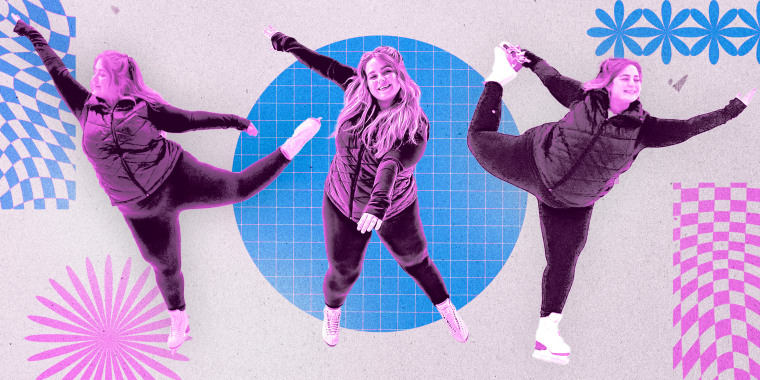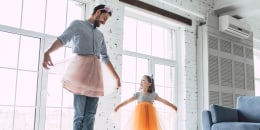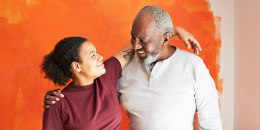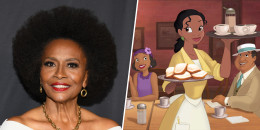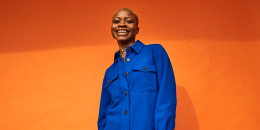Courtney Michaud had everything she needed to compete in her first adult figure skating competition — except for something to wear.
In January, Michaud, 34, started shopping around her hometown of Saint Catharines, Ontario, for an outfit for the competition in March. Michaud expected she’d be among the few, if not the only plus-size person on the ice, and she wanted to look the part to showcase the pride figure skating had brought her in front of an audience.
She went to several boutiques to find skirted leotards and flesh-colored tights, but she recalls to TODAY.com how she quickly realized options for her body type were hard to come by, as she couldn't find either in her size.
“The attire is not inclusive at all,” she says, adding that the skates she buys lack support and break down easier as they aren’t made for someone with her body type as well.
Between handling the impending costs, figuring out how long it would take to get a custom-made dress, getting fitted for more supportive skates and sourcing tights in her size, Michaud decided to drop out a few weeks before the competition, with the understanding that she would try competing again when she had more time to prepare.
But the experience turned out to be an eye-opening one nonetheless. Michaud not only had a better understanding of what skating in her body calls for, but it emphasized the importance of leaning on an online community that she already started building.
Since August, Michaud has been been posting videos of herself skating on her Instagram account, and she’s part of a growing community of skaters on social media celebrating plus-size bodies. Michaud's experience proves body diversity in figure skating confronts longstanding expectations about what skaters’ bodies should look like, and her efforts are part of this bigger online movement to break longstanding stereotypes of who does — and doesn't — belong on the ice.
How she got started in figure skating — and made her return to the sport
Michaud was a figure skater between the ages of 5 and 17, during which she competed at least eight times per year.
As a child, Michaud says she was “painfully shy," but she felt most confident doing artistic skating, which is when the skater interprets the music and focus on footwork instead of jumps. She explains that the elements of artistic skating are “less structured" and her younger self embraced the lack of rigidity.
“I wouldn’t talk, but when I would get on the ice, I would just come alive and ham it up," Michaud recalls.
For most of her years on the ice, Michaud looked like the other young skaters in the rink, but her body started to change when she was about 16. She stopped figure skating after graduating from high school and didn't return to the sport for years.
In 2023, she started noticing an uptick in skaters with body types like hers on social media, and she decided laced up her skates again. Suddenly, at 33, she realized how much she missed being on the ice.
“It never really even crossed my mind that there would be plus-size or curvier skaters because I never really saw that growing up,” Michaud says.
Michaud says skating helps her come out of her shell, just like when she was younger, as do the virtual relationships she’s fostered on social media. When she looks around the rink, she doesn’t see any other plus-size skaters — but online, she’s sees a community.
While Michaud hasn’t met many of the skaters she admires face-to-face, their comments and messages have fueled the way Michaud unapologetically makes space for herself on the ice.
'You can just move your body with joy'
When she got back on the ice as an adult on December 31, 2022, Michaud joined the masses skating in a giant circle at a public rink in St. Catharines. She hoped muscle memory would kick in, but she didn’t last 10 minutes on the ice. The next day, she’d try again, skating slowly and refamiliarizing herself with the balance required to skate on thin blades.
Three months later, she was doing one-footed spins, which her 5-year-old self would be proud of. That’s when she started working with two coaches, Ella Clark and Lisa Woodcock, who trained her and choreographed two routines that she hopes to perform in future competitions.
Figure skating touts talent and enjoyment as its organizing principles, like most sports, but physique has long seemed to be the silent addendum. When discussing body diversity in figure skating, one might make the argument about aerodynamics, questioning how anyone could spin in the air three times or have a partner lift them over their heads without being petite — but Michaud says the jumps and lifts aren’t everything.
"People only focus on what they see in the Olympics," Michaud says. "And there’s other things besides that." Michaud adds that for many people, skating is about exercising, connecting with other people, having a routine and building confidence.
In adulthood, Michaud has found that for her, skating is much less about landing one-footed tricks and how she looks on the ice, but how it makes her feel.
Michaud has returned to artistic skating, which brought her the same self-possession that it did when she was a kid. While Michaud does perform landing elements such as toe loops, salchows and sit spins that are required in a free skating routine, she says that with artistic programs, “you can just move your body with joy."
Progress is stronger as a community
When she first met her coaches, Clark and Woodcock, Michaud was surprised by the absence of judgment.
“It felt really good because I was a bit nervous. I had a stereotype in my head, too, about how they were going to react to me when I said I want to skate and being plus size,” Michaud said. She expected pushback, so she had somewhat of a "guard up."
Michaud is not alone in feeling this fear of rejection as a plus-size skater: Laine Dubin, one of the skaters who inspired Michaud to get back on the ice, has felt this way, too.
A skating coach, videographer and member of the figure skating team at Quinnipiac University in Hamden, Connecticut, Dubin often goes viral on social media for her ice skating videos, but admits to doubting herself at times as a plus-size figure skater.
“It’s been a really bumpy ride for (me) internally,” Dubin tells TODAY.com. Prone to overthinking, “I’m always looking out to see if I’m the biggest person on the ice and kind of sizing up other people.”
While her coaches and teammates have never made her feel different, she’s aware that she’s shirking what a stereotypical ice skater looks like by existing. As a coach, she hopes that her students seeing her succeed on the ice will suppress this mindset moving forward.
Feedback on social media has helped her overcome societal expectations, too. “(People commenting), 'You're supposed to be here, you’re allowed to be here, you’re allowed to take up space on the ice,' is something that I just need to keep hearing,” Dubin says. “And it’s nice to have a whole community online to kind of fall back on and to remind me that I’m still allowed to ... do what I love.”
Similarly, ice skater Ebiere Keregha has found drive in the positive response she's gotten from her social media presence. She tells TODAY.com that being a Black and plus-size skater has “always just kind of been my thing," but thanks to social media, she's realized that "there are people out here who look like me, who want to do this and are waiting for the inspiration."
"Well, girl, here we are. Here we are," Keregha says, predicting that the uptick in the visibility of body diversity on the ice will demand reinvention.
But Michaud, Dubin and Keregha feel like they don't have many, if any mainstream plus-size skaters whom they can turn, or whose impact has resulted in structural change, forcing the sport to shed signifiers of who belongs. They’re on their own, making the most of the resources available to them, which never considered them to begin with. So, having an online community to lean into is especially vital.
How can body inclusivity in figure skating move forward?
Michaud says figure skating has an “old-school mentality” that has made the sport slow to progress, and it’s impacted even those whose talents and body types have been historically celebrated.
In Olympian Gracie Gold's memoir, “Outofshapeworthlessloser,” which came out earlier this year, she opens up about her mental health struggles and an eating disorder.
“In the culture of skating, we don’t talk about those things out loud,” Gold said during a TODAY appearance in February, revealing she was advised by people in the skating community to “water down” this crisis for which she went to rehab to keep up skating appearances. In her book, she reveals she was constantly thinking about her body and scrutinizing it, determined to be smaller than she was.
U.S. Figure Skating’s Director of Diversity, Equity and Inclusion Kadari Taylor-Watson tells TODAY.com that the definition of a "traditional skater" is riddled in "bias and racism and sexism."
“The problem is that people don’t see themselves in (figure skating),” she says. “But that doesn’t mean the spaces aren’t there. And so, I think we have to do a better job of encouraging people to understand that there are no specific barriers for you to follow whatever journey you want in the sport.”
Taylor-Watson says that progress calls for a two-pronged approach from the sport: First, people need to see themselves in these spaces, and second, they should feel safe.
Much of skating calls for uniformity in movement and in appearance, but “sameness and unison are not interchangeable,” she adds. Apparel, skates and tools that cater to all body types would allow skaters to perform at their best and “show up on the ice as (their) best selves,” she notes, and that it's up to the sport to determine those needs.
But for now, Michaud and other plus-size skaters are leaning on their social media communities, hopeful that change eventually makes it off their apps.
It’s worth noting that plus-size women aren’t the only ones bucking against the expectations of the sport. Nonbinary skater Timothy LeDuc represented the United States at the 2022 Winter Olympics and trans nonbinary skater Eliot Halverson is a three-time national champion. Older skaters and skaters of color, such as Joel Savary, are making the sport more inclusive by getting on the ice, too.
I think we have to do a better job of encouraging people to understand that there are no specific barriers for you to follow whatever journey you want in the sport.
U.S. Figure Skating’s Director of Diversity, Equity and Inclusion Kadari Taylor-Watson
With more time to prepare, Michaud is giving competing a second try in the fall. This go-around, she will have a dress made for her and scope out flesh-toned tights in her size, likely from a non-skating company. She also recently invested in a new pair of skates.
Ideally, companies will expand sizing for skating apparel and manufacture durable skates for bodies of all sizes, but for now, plus-size skaters are prioritizing making themselves known and leaning into the pleasures of being on the ice and the community that knows they belong in the rink.
Michaud says that footage of her routine, when it happens, will inevitably end up online, showing her followers what it looks like to compete, even if they don't know what she went through to get there. Still, she's optimistic they’ll take something away from watching it — as with any of her social media posts — be it inspiration or awareness. As her own audience’s assumptions about figure skating may change over time, hopefully the sport itself will follow suit.
